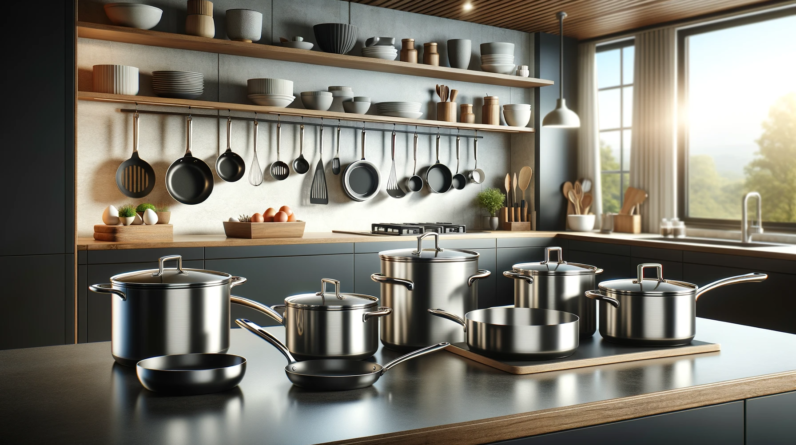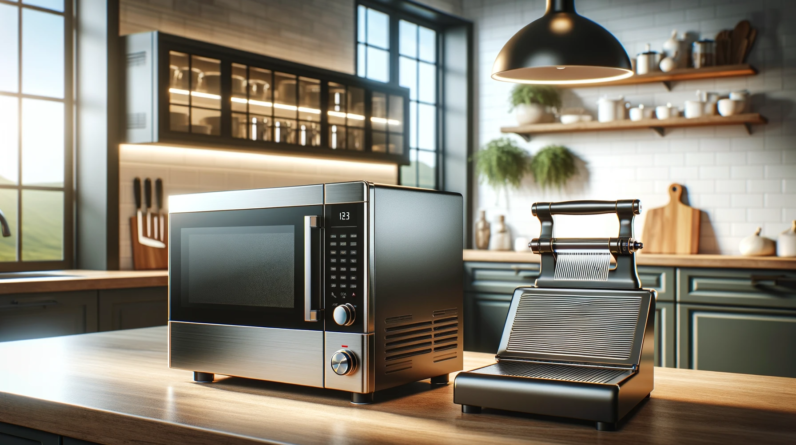
Disclaimer: This post may contain affiliate links. As an Amazon Associate, we earn from qualifying purchases.
Imagine a world without utensils. It’s a difficult concept to grasp, isn’t it? Utensils are an integral part of our lives, aiding us in the simplest of tasks like stirring our morning coffee or enjoying a hearty meal. But have you ever wondered which utensil reigns supreme in terms of versatility?
Well, buckle up because we’re about to embark on a journey to uncover the answer to that very question. From spatulas to spoons, knives to tongs, we’ll explore the countless possibilities each utensil offers and finally crown the winner as the most versatile of them all.
Get ready to discover the unsung hero that has the power to transform your culinary experiences forever!
What is the most versatile utensil?
Whether you’re an avid home cook or a professional chef, having versatile utensils in your kitchen is essential. They are the workhorses of the culinary world, capable of performing multiple tasks and making your cooking experience easier and more efficient.
But with so many options available, it can be challenging to determine which utensil reigns supreme in terms of versatility. In this article, we will explore the factors that determine versatility, the different types of versatile utensils, and the benefits of using them. We will also delve into the characteristics, historical significance, and innovations in these remarkable kitchen tools.
Definition of a versatile utensil
 Before we dive into the world of versatile utensils, it’s important to understand what exactly classifies a utensil as versatile. A versatile utensil is one that can perform multiple functions, making it suitable for a wide range of cooking tasks.
Before we dive into the world of versatile utensils, it’s important to understand what exactly classifies a utensil as versatile. A versatile utensil is one that can perform multiple functions, making it suitable for a wide range of cooking tasks.
It is a tool that can adapt to different recipes and cooking techniques, allowing you to prepare various dishes with minimal effort and maximum efficiency.
Factors that determine versatility
Several factors contribute to a utensil’s versatility.
The most crucial factor is its functionality – how many different tasks it can perform. A versatile utensil should be capable of cutting, whisking, stirring, scooping, and even serving.
It should also be compatible with different types of cookware, such as non-stick pans, stainless steel pots, or cast iron skillets.
Another factor that plays a role in determining versatility is the material of the utensil. Utensils made of high-quality materials such as stainless steel, silicone, or heat-resistant nylon tend to be more versatile due to their durability, heat resistance, and non-reactivity with various ingredients.
Ease of maintenance is another aspect to consider. Versatile utensils should be dishwasher safe, easy to clean, and resistant to stains and odors. This ensures that they can be used for multiple tasks without any lingering flavors or aromas.
Types of versatile utensils
There are numerous versatile utensils available on the market today, each catering to specific cooking tasks. Some of the most popular and versatile options include:
- Chef’s knife: This all-purpose knife is a must-have in any kitchen. Its sharp blade and comfortable handle make it ideal for slicing, dicing, chopping, and even mincing herbs.
- Silicone spatula: With its heat-resistant properties and flexible head, a silicone spatula is perfect for scraping the bottom of pots and pans, as well as folding ingredients together.
- Tongs: Tongs are incredibly versatile and can handle anything from flipping meat on a grill to tossing salads. Look for tongs with a comfortable grip and a locking mechanism for easy storage.
- Whisk: Whisks are not just for beating eggs; they are great for blending ingredients, whisking dressings, and creating smooth sauces.
- Multi-purpose shears: These handy tools can perform a variety of functions, including cutting, trimming, and even opening food packaging.
Comparison of versatile utensils
 When it comes to comparing versatile utensils, it’s essential to consider factors such as functionality, durability, and ease of use. Assessing these factors will help you determine which utensil will best suit your cooking needs.
When it comes to comparing versatile utensils, it’s essential to consider factors such as functionality, durability, and ease of use. Assessing these factors will help you determine which utensil will best suit your cooking needs.
The chef’s knife, for instance, reigns supreme in terms of versatility due to its ability to handle a wide range of slicing and dicing tasks. Its sharp blade allows for precise cutting, and its ergonomic handle ensures comfort during extended use.
On the other hand, a silicone spatula is an excellent choice for those who frequently cook with non-stick cookware.
Its non-scratch properties protect your pan’s surface while allowing you to scrape every last bit of food effortlessly.
Tongs and whisks also rank high in terms of versatility. Tongs provide a secure grip that is ideal for grilling, stove-top cooking, and even serving, while whisks are essential for creating light and airy textures in batters and sauces.
Multi-purpose shears, although often overlooked, are incredibly versatile in their own right. They can be used for various cutting tasks, including trimming excess fat from meat, snipping herbs, and even cracking open lobster shells.
Benefits of using versatile utensils
Using versatile utensils in your kitchen can bring numerous benefits to your cooking and overall culinary experience. Firstly, versatile utensils save you valuable storage space by eliminating the need for multiple specialized tools. With a few key utensils, you can tackle a wide range of culinary tasks, making your kitchen more organized and clutter-free.
Secondly, having versatile utensils at your disposal saves you time and effort. Instead of switching between numerous tools while preparing a meal, you can rely on a single utensil that can effectively perform multiple tasks. This not only streamlines your cooking process but also reduces clean-up time.
Additionally, using versatile utensils allows for more creativity in the kitchen. They empower you to explore different recipes and cooking techniques, knowing that you have the right tools to handle anything that comes your way.
Whether you’re sautéing vegetables, sizzling meat, or whisking up a delightful dessert, versatile utensils provide the flexibility and reliability you need to bring your culinary visions to life.
Characteristics of a versatile utensil
When choosing versatile utensils, certain characteristics stand out as indicators of their adaptability and functionality. Firstly, a versatile utensil should have a durable construction, capable of withstanding regular use and the rigors of different cooking tasks.
High-quality materials such as stainless steel, silicone, and nylon are known for their durability and resilience.
Comfort is another important characteristic. Look for utensils with ergonomic handles that offer a secure grip and minimize hand fatigue. This ensures that you can comfortably handle the utensil for extended periods without compromising your cooking experience.
Versatile utensils should also be designed with practicality in mind. A tool that is dishwasher safe, easy to clean, and resistant to stains and odors ensures that it can be quickly reused for various tasks, without any lingering flavors or aromas.
Versatile utensils in different cuisines
Versatility in utensils transcends cultural boundaries, and different cuisines around the world rely on versatile tools to bring their unique flavors to life. Let’s explore how versatile utensils play a role in some of the most beloved world cuisines:
- Italian cuisine: The pasta fork and colander are essential utensils in Italian cooking. The pasta fork allows for easy serving and precise portion control, while the colander ensures perfectly drained pasta every time.
- Mexican cuisine: A molcajete, similar to a mortar and pestle, is a versatile tool used to grind spices, make guacamole, and prepare salsas.
- Indian cuisine: The tawa, a flat griddle used for cooking bread, is a versatile utensil that allows for the preparation of a variety of Indian flatbreads, from roti to naan.
- Chinese cuisine: A wok is an iconic versatile utensil in Chinese cooking. Its round shape and high sides make it perfect for stir-frying, deep-frying, and even boiling.
- Middle Eastern cuisine: The mezzaluna, a curved chopping knife, is a versatile tool used in Middle Eastern cuisine for finely chopping herbs and vegetables.
Historical significance of versatile utensils
Versatile utensils have played a significant role in the evolution of cooking and culinary traditions throughout history. From the dawn of civilization, humans have relied on versatile tools to transform raw ingredients into delicious meals.
For example, the invention of the knife allowed our ancestors to cut and prepare food more efficiently, leading to faster cooking times and improved overall nutrition. Similarly, the development of the mortar and pestle enabled early civilizations to grind grains and spices, resulting in the creation of more diverse and flavorful dishes.
As human civilizations progressed, so did the utensils we used in our culinary endeavors. Metal utensils, such as spoons and ladles, replaced earlier iterations made from wood or bone, making it easier to cook and serve food. These advancements in versatile utensils paved the way for the culinary innovations we enjoy today.
Popular versatile utensils: pros and cons
While the choice of versatile utensils varies from person to person, certain tools have gained widespread popularity due to their functionality and adaptability. Let’s take a closer look at a few popular versatile utensils, along with their pros and cons:
- Chef’s knife:
- Pros: Suitable for a wide range of cutting tasks, provides precise control, and allows for efficient ingredient preparation.
- Cons: Requires proper handling and regular sharpening to maintain optimal performance.
- Silicone spatula:
- Pros: Heat-resistant, non-scratch properties, ideal for non-stick cookware, and excellent for scraping every last bit of food.
- Cons: Can be less effective at heavy-duty tasks such as cutting or slicing.
- Tongs:
- Pros: Secure grip, versatile uses from grilling to serving, and easy storage with a locking mechanism.
- Cons: Limited precision when compared to other utensils.
- Whisk:
- Pros: Blend ingredients thoroughly, create light and airy textures, and ease of use.
- Cons: May not be suitable for heavy mixing or incorporating thicker ingredients.
- Multi-purpose shears:
- Pros: Perform a variety of cutting tasks, including trimming, cutting packaging, and even cracking open shells.
- Cons: Less effective for precise slicing or chopping.
Innovations in versatile utensils
 The world of kitchen utensils continues to evolve, with ongoing innovations aimed at enhancing versatility and ease of use.
The world of kitchen utensils continues to evolve, with ongoing innovations aimed at enhancing versatility and ease of use.
One notable innovation is the development of multi-function utensils, combining the functionality of several tools into one compact and efficient package.
For instance, some manufacturers have created utensils that incorporate both a spatula and tongs, allowing for seamless flipping, grabbing, and serving of food.
These hybrid utensils provide the convenience of two tools in one, saving space in your kitchen drawer and simplifying your cooking process.
Technological advancements have also influenced the versatility of utensils.
The introduction of heat-resistant materials like silicone and nylon has revolutionized the way utensils are used in high-heat cooking methods. Additionally, the integration of ergonomic designs and non-slip handles ensures optimal comfort and control, making the cooking experience more enjoyable and efficient.
In conclusion, determining the most versatile utensil depends on individual needs, preferences, and cooking styles. However, whether it’s the ever-reliable chef’s knife, the adaptable silicone spatula, or the indispensable tongs, versatile utensils play a crucial role in every kitchen.
Embracing these remarkable tools not only simplifies your cooking process but also unlocks a world of culinary possibilities. So, equip your kitchen with the right utensils, and let your creativity flourish as you embark on new culinary adventures. Happy cooking!





